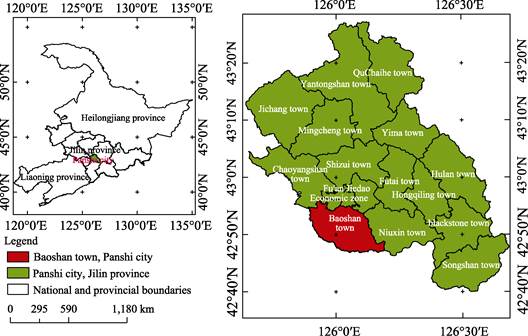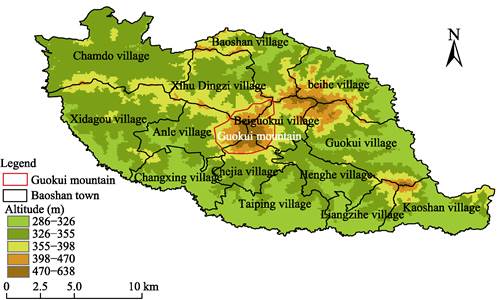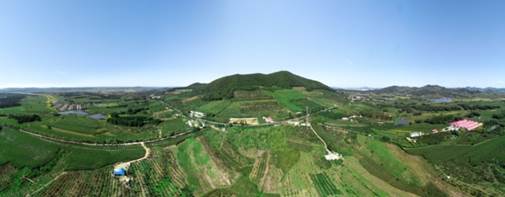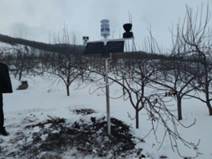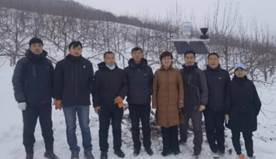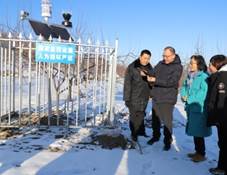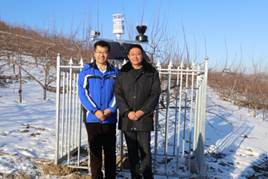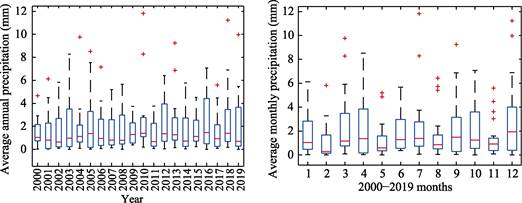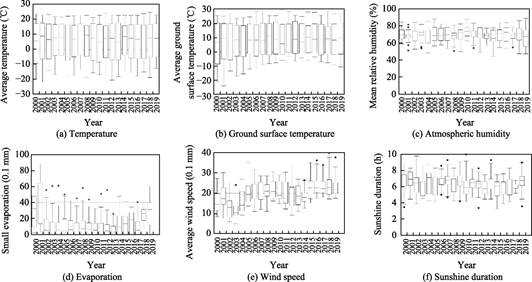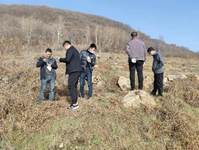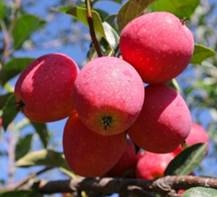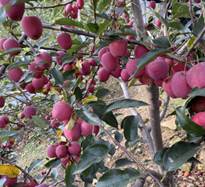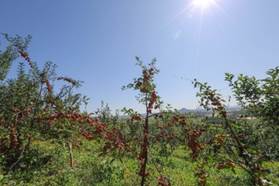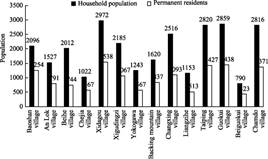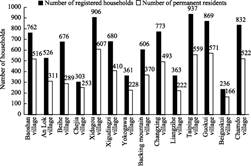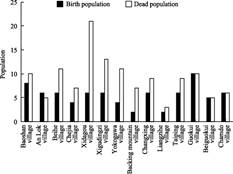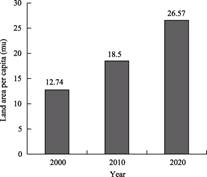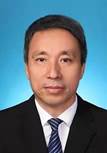Panshi Chinese Cherry Apple Baoshan Township Case in Low Mountains and Hills
Abstract
The Chinese cherry apple is a cultivated variety of apple from Rosaceae (Malus domestica). It is mainly distributed in Northeast China and has adapted to the cold climate. Its fruit is small in size, bright in color and rich in flavor. It has a certain competitive advantage in the segmented fruit market. The case of study area is located in Mt. Guokui area, Baoshan town, Panshi city, Jilin province. The terrain of the case area is a gentle slope in the transition zone from Changbai mountain to Songnen plain. The soil is loamy black soil and chernozem associated with sand and gravel. The irrigation water source is pollution-free mountain spring water, with a quality better than the urban drinking water. These superior natural conditions have produced Chinese cherry apple with unique geographical characteristics. In 2020, the planting area of this fruit in Baoshan town was 650 ha. Due to the stable natural conditions, the total fruit output will be basically stable. The future work of the case area will focus on building fruit production and circulation standards, improving infrastructure, transforming the resource and product advantages into market advantages, creating more employment opportunities for local residents, attracting population return, and supporting rural revitalization. This case dataset includes the ecological data (geographical location, DEM, climate, hydrology, soil); product characteristics data; social, economic and management data; and tradition data. The case dataset were archived in .shp, .tif , .xlsx , .docx , .png, and .jpg formats with a data size of 69.8 MB.
Introduction
The Baoshan town is affiliated with Panshi city, Jilin province of China. It is located between 125°53¢00² E–126°11¢00²E and 42°46¢00²N–42°56¢00²N. Baoshan town is located in the southwest of Panshi city, bordering the Panshi Economic and Technological Development Zone and Niuxin town in the east, Huinan town in the south, and Niuxindingzi town and Xinghua town in Meihekou city across the Liangzi river in the north. It is positioned at the junction of Chaoyangshan town and Fu’an street, covering an area of 241.75 km2 (Figure 1).
Because of the transition zone from the Changbai mountain to Songnen plain, the town is characterized by low mountains and hills[1,2]. The highest mountain in the territory, Guokui mountain, is 650 m a.s.l., and the lowest point is Dangliangzi river, 276 m above sea level. The case area belongs to the north temperate continental monsoon climate, the water resources in the territory are very rich, and the water quality is good. The river water quality indicators meet the national standards, and the ambient air quality is excellent. The four seasons are distinct, and the temperature and humidity seasons rotated[3,4]. The area has typical mountain agricultural climate characteristics, making it very suitable for fruit growth[5,6] (Figure 2, 3).
Metadata of the Dataset
The metadata of the case dataset[7] is summarized in Table 1.
Table 1 Metadata summary of Panshi Baoshan Chinese cherry apple case datasets
| Items | Descriptions |
|---|---|
| Dataset full name | Panshi Chinese cherry apple Baoshan low mountains and hills case dataset on ecosystem protection and sustainable development |
| Dataset short name | BaoshanCherryAppleCase06 |
| Authors | Chen, S. B., College of Earth Exploration Science and Technology (CEEST), Jilin University, chensb@jlu.edu.cn Ye, Y. H., CEEST, Jilin University, yyh13@jlu.edu.cn Fu, J. Y., Institute of Geographic Sciences and Natural Resources Research, Chinese Academy of Sciences (IGSNRR/CAS), fujy@igsnrr.ac.cn Zhang, M. J., Institute of Fruit Trees, Jilin Academy of Agricultural Sciences Qiao, Y. B., Bureau of Agriculture and Rural Affairs of Panshi City, pssnyj@163.com Chen, C. H., Bureau of Agriculture and Rural Affairs of Panshi City Yao, L. P., Baoshan Town, Panshi City Wu, L. G., Baoshan Town, Panshi City |
| Luan, R. S., Jilin Panbao Agricultural Products Co., Ltd. Qi, Z. M., Jilin Panbao Agricultural Products Co., Ltd. Zhu, X. G., Beijing TianhangHuachuang Technology Co., Ltd., 18510867688@163.com Liu, C. L-3684-2016, IGSNRR/CAS, lchuang@igsnrr.ac.cn | |
| Geographic region | Guokui mountain region of Baoshan town, Panshi city, Jilin city, Jilin province |
| Sampling date | 2000–2021 |
| Data format | .shp, .tif, .xlsx, .docx, .jpg, .png |
| Data size | 69.8 MB |
| Data files | The dataset contains 5 folders (the scope of the study area, physical geography data, variety characteristic data, management data, and product cultural history and tradition data) |
| Foundation | Ministry of Science and Technology of P. R. China (2020YFA0714103) |
| Data publisher | Global Change Research Data Publishing & Repository, http://www.geodoi.ac.cn |
| Address | No. 11A, Datun Road, Chaoyang District, Beijing 100101, China |
| Data sharing policy | Data from the Global Change Research Data Publishing & Repository includes metadata, datasets (in the Digital Journal of Global Change Data Repository), and publications (in the Journal of Global Change Data & Discovery). Data sharing policy includes: (1) Data are openly available and can be free downloaded via the Internet; (2) End users are encouraged to use Data subject to citation; (3) Users, who are by definition also value-added service providers, are welcome to redistribute Data subject to written permission from the GCdataPR Editorial Office and the issuance of a Data redistribution license; and (4) If Data are used to compile new datasets, the ‘ten per cent principal’ should be followed such that Data records utilized should not surpass 10% of the new dataset contents, while sources should be clearly noted in suitable places in the new dataset[8] |
| Communication and searchable system | DOI, CSTR, Crossref, DCI, CSCD, CNKI, SciEngine, WDS/ISC, GEOSS |
DOI: https://doi.org/10.3974/geodp.2021.04.02
CSTR: https://cstr.escience.org.cn/CSTR:20146.14.2021.04.02
Dataset Availability Statement:
The dataset supporting this paper was published and is accessible through the Digital Journal of Global Change Data Repository at https://doi.org/10.3974/geodb.2021.12.41.V1 or https://cstr.escience.org.cn/CSTR:20146.11.2021.12.41.V1
Ecological Data
The ecological data collected for this case study were from ecological stations, unmanned aerial vehicle (UAV, drone), meteorological station, field survey and lab analysis of soil or water, and hydrological stations.
Data from Automatic Ecological Monitoring Station and Meteorological Station
In order to better trace the fruit growth environment, in November 2021, an automatic ecological station in a Chinese cherry apple orchard was installed. This station was developed by Beijing Tianhang Huachuang Technology Co., Ltd., and composed of low-power IoT sensors that had passed the quality calibration and inspection of Shenzhen Tiansu Metrology and Testing Co., Ltd. (Figure 4–6). Its functions included automatic acquisition, identification, and transmission of data on ecological elements, such as air, soil, water quality, vegetation phenology, pests and diseases. Baoshan town was responsible for the operation (Figure 7). In addition, the aerial images of the fruit plantation was collected using a drone with a multi-spectral camera (Figure 8); the images can clearly show the field conditions, such as the scattered stones on the ground surface (Figure 9). Together with long-term climate data from traditional stations (Figure 10, 11), these observation data can be better used to assist the decision-making of orchard management.
| Figure 8 A mosaic subset of multi-spectral image of orchard (by Zhang, Y. H. on November 4, 2021) | Figure 9 A zoom-in of a multi-spectral image (by Zhang, Y. H. on November 4, 2021) |
|---|---|
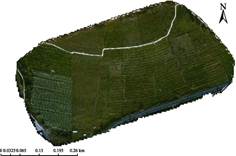 |
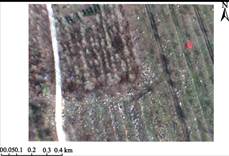 |
Soil Physicochemical Analysis Data
Soil samples were collected from two orchards. The soil types were mainly black soil and chernozem soil. The color of the surface soil was darker, the color gradually became lighter downward, and the soil color was brown near the depth of 50 cm. The soil sampling depths were in 5 layers: 0–10, 10–20, 20–30, 30–40, and 40–50cm. The soil texture is loamy soil associated with sand and gravel, which is conducive to the rooting and growth of fruit trees as well as the water permeability.
The nitrogen content percentage (N%), carbon content percentage (C%), and carbon– nitrogen ratio (C/N) of the soil samples were tested. Among the 10 samples of the two types of soil tested, the nitrogen (N) content was about 0.07% to 0.57%, the carbon (C) content was about 0.55% to 6.24%, and the C to N ratio was 8.44 to 12.21 (Table 2). Among these, the soil carbon and nitrogen contents at the site 126°2′26.8″E, 42°50′26.48″N were generally higher than those at site 126°2′26″E, 42°50′21.8″N. From a longitudinal comparison, it could be determined that the carbon and nitrogen contents gradually decreased from the topsoil down, which was related to the mountainous terrain where the trees were planted. The C and N ratios of the soils at the two sites were very close, with little change. The heavy metal contents of the soil were better than the national standard about pollution content required value[1] (Table 3).
Table 2 Soil carbon and nitrogen content in the case area
| Soil Samples | Site 1 (126°2′26.8″E, 42°50′26.48″N) | Site 2 (126°2′26″E, 42°50′21.8″N) | ||||||||
|---|---|---|---|---|---|---|---|---|---|---|
| Depth (cm) | 0–10 | 10–20 | 20–30 | 30–40 | 40–50 | 0–10 | 10–20 | 20–30 | 30–40 | 40–50 |
| N% | 0.57 | 0.42 | 0.3 | 0.09 | 0.15 | 0.4 | 0.23 | 0.24 | 0.1 | 0.07 |
| C% | 6.24 | 4.89 | 3.52 | 0.96 | 1.79 | 4.29 | 2.31 | 2.49 | 1.08 | 0.55 |
| C/N | 10.95 | 11.77 | 11.73 | 10.11 | 12.21 | 10.68 | 10.12 | 10.44 | 11.06 | 8.44 |
Table 3 Element contents of soil samples at Site 1
| Heavy metals | Depth 0–10cm | Depth 10–20cm | Depth 20–30cm | Depth 30–40cm | Depth 40-50cm |
|---|---|---|---|---|---|
| Li (mg/kg) | 29.94 | 30.90 | 32.03 | 24.82 | 23.41 |
| B (mg/kg) | 27.00 | 26.78 | 24.19 | 20.86 | 20.34 |
| Na (mg/kg) | 16,950.59 | 15,938.96 | 17,009.83 | 21,523.84 | 22,007.76 |
| Mg (mg/kg) | 7,521.23 | 6,109.62 | 6,127.24 | 5,232.81 | 5,115.00 |
| Al (mg/kg) | 88,103.72 | 45,951.92 | 52,110.39 | 76,583.89 | 58,631.70 |
| P (mg/kg) | 1050.42 | 904.72 | 728.14 | 406.58 | 469.64 |
| K (mg/kg) | 23,325.88 | 19,087.82 | 21,386.66 | 26,145.22 | 19,741.44 |
| Ca (mg/kg) | 11,041.88 | 5,149.27 | 5,434.21 | 7,355.44 | 5,445.48 |
| Sc (mg/kg) | 3.24 | 1.71 | 2.50 | 0.42 | 0.51 |
| Ti (mg/kg) | 3,735.38 | 3,638.54 | 3,752.04 | 3,464.82 | 3,501.51 |
| Mn (mg/kg) | 966.40 | 705.13 | 583.26 | 783.41 | 535.44 |
| Fe (mg/kg) | 29,500.20 | 27,494.66 | 26,363.38 | 23,454.69 | 23,683.87 |
| Ba (mg/kg) | 508.95 | 407.83 | 461.46 | 439.34 | 441.08 |
| La (mg/kg) | 48.15 | 37.26 | 39.30 | 29.95 | 29.97 |
| V (mg/kg) | 76.21 | 74.85 | 74.42 | 67.92 | 63.98 |
| Co (mg/kg) | 13.17 | 14.57 | 11.84 | 12.68 | 10.17 |
| Ni (mg/kg) | 209.71 | 164.60 | 165.50 | 146.49 | 180.18 |
| Cu (mg/kg) | 18.80 | 16.63 | 15.70 | 9.52 | 10.84 |
| Zn (mg/kg) | 85.40 | 67.75 | 63.25 | 42.88 | 47.52 |
| Sr (mg/kg) | 186.63 | 111.53 | 123.87 | 157.15 | 134.14 |
| Cd (mg/kg) | 0.407 | 0.176 | 0.138 | 0.093 | 0.211 |
| Pb (mg/kg) | 35.39 | 24.51 | 22.59 | 23.75 | 20.65 |
| Hg (mg/kg) | 0.055 | 0.057 | 0.048 | 0.060 | 0.029 |
Irrigation Water Quality in Baoshan Town
The irrigation water sources in the fruit tree planting area of Baoshan town were precipitation and runoff. The case datasets contained the water quality data of 5 samples in the case area (Table 4), and 25 elements and ions were analyzed such as Al, As, and B. The water sample testing results were compared with the urban drinking water supply standards and the drinking water sanitation standards, and it was found that all indicators of water quality near Guokui mountain were excellent.
Table 4 Irrigation water quality in Guokui mountain region
| Indicator (mg/L) | Sample 1 | Sample 2 | Sample 3 | Sample 4 | Sample 5 | Urban drinking water supply standard | Hygienic standard for drinking water | |
|---|---|---|---|---|---|---|---|---|
| Vanadium | V | 0.014,0 | 0.018,5 | 0.015,3 | 0.014,1 | 0.022,2 | – | – |
| Chromium | Cr | 0.015,1 | 0.016,9 | 0.016,3 | 0.015,1 | 0.017,8 | 0.05 | 0.05 |
| Cobalt | Co | 0.000,12 | 0.000,12 | 0.000,23 | 0.000,10 | 0.000,19 | – | – |
| Nickel | Ni | 0.001,5 | 0.001,8 | 0.001,9 | 0.001,7 | 0.002,3 | 0.02 | – |
| Copper | Cu | 0.001,7 | 0.002,3 | 0.002,2 | 0.002,0 | 0.005,9 | 1 | 1 |
| Zinc | Zn | 0.002,7 | 0.007,1 | 0.004,9 | 0.016,7 | 0.030,7 | 1 | 1 |
| Arsenic | As | 0.002,7 | 0.002,8 | 0.003,0 | 0.002,1 | 0.003,2 | 0.01 | 0.05 |
| Strontium | Sr | 0.079 | 0.117 | 0.131 | 0.088 | 0.192 | – | – |
| Molybdenum | Mo | 0.0014 | 0.002,0 | 0.000,6 | 0.000,3 | 0.002,1 | 0.07 | – |
| Cadmium | Cd | 0.000,034 | 0.000,022 | 0.000,037 | 0.000,028 | 0.000,030 | 0.00,3 | 0.01 |
| Lead | Pb | 0.0018 | 0.001,4 | 0.001,2 | 0.003,8 | 0.001,5 | 0.01 | 0.05 |
| Lithium | Li | 0.000,065 | 0.000,068 | 0.000,064 | 0.000,063 | 0.000,070 | – | – |
| Boron | B | 0.048 | 0.040 | 0.043 | 0.049 | 0.071 | 0.5 | – |
| Sodium | Na | 5.153 | 8.001 | 9.356 | 8.315 | 11.731 | 200 | – |
| Magnesium | Mg | 3.280 | 3.582 | 4.909 | 3.441 | 5.428 | – | – |
| Aluminum | Al | 0.258 | 0.170 | 0.247 | 0.191 | 0.669 | 0.2 | – |
| Phosphorus | P | 0.227 | 0.171 | 0.175 | 0.159 | 0.152 | – | – |
| Potassium | K | 1.548 | 1.453 | 1.868 | 1.068 | 1.757 | – | – |
| Calcium | Ca | 11.716 | 20.934 | 20.487 | 14.121 | 30.724 | – | – |
| Manganese | Mn | 0.004 | 0.002 | 0.016 | 0.003 | 0.005 | 0.1 | 0.1 |
| Iron | Fe | 0.205 | 0.089 | 0.279 | 0.096 | 0.392 | 0.3 | 0.3 |
| Barium | Ba | 0.008 | 0.008 | 0.020 | 0.026 | 0.040 | 0.7 | – |
| Sulfate | SO42– | 27.02 | 9.36 | 14.04 | 28.79 | 20.19 | 250 | – |
| Carbonate | CO32– | 0.00 | 1.00 | 2.00 | 3.00 | 4.00 | – | – |
| Chloride | Cl– | 6.53 | 5.96 | 12.21 | 8.24 | 9.94 | – | – |
Chinese Cherry Apple
The Biological Characteristics of Chinese Cherry Apple
Chinese cherry apple is a cultivar of apple species in the genus Malus of Rosaceae. This variety is mainly distributed in Northeast China and adapts to the cold climate. Locals also call it “chicken-heart-shaped apple” due to the looks of its fruit. The Chinese cherry apple tree is tall and has a rounded crown. It sprouts in mid-April and blooms in early May, with 5 to 8 flowers per inflorescence. Each flower has 5 petals adjoining, with the petals being oval and separate, and the diameter of the corolla is 3.2 cm (Figure 14). The fruit swells in late May and begins to color in late August. The fruit matures in the middle of the month, becoming long and conical, with an average weight of about 60 g (Figure 15). The fruit development period is 120 days. It takes a cultivation period of 3 to 4 years for the tree to yield fruit, and 7 to 8 years for the tree to enter the high-yield period. Normally, per plant yields 10 kg in the third year, 50 kg in the fourth year, and 75 kg in the fifth year after high head replacement (Figure 16).
The fruit of the Chinese cherry apple has 17.22% of sugar and 0.467% of acid, with 98% being edible. The fruit is fragrant and palatable, and its fragrance exceeds that of quality apples. It contains a lot of juice; has crispy, fragrant, yellow-white flesh; and excellent sensory qualities. The harvest period of Chinese cherry apple in Panshi is mid-to-late September. The surface of the fruit is bright red, the fruit does not drop easily, and it is resistant to storage and transportation. The harvest period can be extended to the period after October 1st to before the first frost. The fruit development period is 120 days. It can be stored at room temperature for 1 to 2 months or refrigerated for 3 to 4 months[ 9–12] . Baoshan town has a fruit tree planting area of 650 ha, the annual yield of the fruit is about 30,000 tons (Figure 17).
Elemental Measurements of Chinese Cherry Apple Tree Root, Branch, and Leaf
We selected two Chinese cherry apple fruit tree samples, conducted carbon and nitrogen content detection, and calculated the carbon–nitrogen ratio for their roots, branches, and leaves (Table 5). In addition, the contents of 23 elements were tested (Table 6[2]). The test results in Table 5 and Table 6 suggest that the Chinese cherry apple at Baoshan town, Panshi is safe in terms of its carbon–nitrogen ratio and heavy metal contents.
Table 5 C and N content of Chinese cherry apple trees at Baoshan town
| Sample | Sample tissue | N% | C% | C/N |
|---|---|---|---|---|
| Fruit Tree Sample 1 | Root | 1.12 | 46.03 | 41.06 |
| Branches | 1.14 | 45.66 | 40.08 | |
| Leaves | 1.55 | 49.51 | 32.04 | |
| Fruit Tree Sample 2 | Root | 0.84 | 48.68 | 57.77 |
| Branches | 0.80 | 47.78 | 59.93 | |
| Leaves | 1.83 | 48.15 | 26.36 |
Table 6 Contents of 23 elements in roots, branches, and leaves of Chinese cherry apple tree at Baoshan
| Element | Sample 1 | Sample 2 | ||||
|---|---|---|---|---|---|---|
| Root | Branches | Leaves | Root | Branches | Leaves | |
| Li (mg/kg) | 1.29 | 1.07 | 1.08 | 1.11 | 1.07 | 1.00 |
| B (mg/kg) | 79.27 | 145.29 | 580.82 | 684.48 | 843.61 | 371.46 |
| Na (mg/kg) | 1,454.68 | 618.55 | 579.05 | 684.71 | 596.53 | 537.63 |
| Mg (mg/kg) | 2,338.82 | 2,400.36 | 5,061.59 | 1,979.77 | 2,194.39 | 3,833.93 |
| Al (mg/kg) | 46,331.98 | 32,029.73 | 32,255.52 | 29,968.64 | 32,664.29 | 35,741.56 |
| P (mg/kg) | 1,119.29 | 1,100.39 | 1,025.92 | 981.68 | 918.80 | 1,398.11 |
| K (mg/kg) | 4,498.15 | 4,468.05 | 12,993.82 | 4,572.97 | 4,219.49 | 13,063.18 |
| Ca (mg/kg) | 13,417.19 | 22,877.59 | 21,670.69 | 10,308.81 | 20,750.03 | 27,514.59 |
| Sc (mg/kg) | 0.60 | 0.18 | 0.47 | 0.20 | 0.22 | 0.55 |
| Ti (mg/kg) | 163.83 | 57.27 | 59.28 | 53.86 | 53.91 | 59.95 |
| Mn (mg/kg) | 300.32 | 182.41 | 289.13 | 150.16 | 174.95 | 231.07 |
| Fe (mg/kg) | 4,944.92 | 2,217.67 | 1,827.70 | 2,004.50 | 2,102.24 | 2,167.80 |
| Ba (mg/kg) | 103.52 | 112.81 | 109.76 | 68.89 | 95.76 | 118.11 |
| La (mg/kg) | 14.96 | 9.86 | 8.30 | 9.65 | 8.85 | 9.31 |
| V (mg/kg) | 9.46 | 6.04 | 4.15 | 5.15 | 4.86 | 3.66 |
| Co (mg/kg) | 1.48 | 0.59 | 0.36 | 0.44 | 0.38 | 0.28 |
| Ni (mg/kg) | 5.49 | 4.52 | 2.48 | 2.62 | 3.00 | 3.57 |
| Cu (mg/kg) | 4.36 | 5.67 | 5.23 | 3.59 | 5.54 | 4.99 |
| Zn (mg/kg) | 30.81 | 55.06 | 16.59 | 11.03 | 34.48 | 15.53 |
| Sr (mg/kg) | 169.05 | 220.96 | 192.94 | 116.58 | 181.49 | 216.29 |
| Cd (mg/kg) | 0.091 | 0.066 | 0.043 | 0.053 | 0.094 | 0.036 |
| Pb (mg/kg) | 4.26 | 2.53 | 2.66 | 2.38 | 2.79 | 2.74 |
| Hg (mg/kg) | 0.014 | 0.018 | 0.021 | 0.011 | 0.012 | 0.021 |
Social, Economy and Business Management in Case Study
The Resident Population has Decreased Significantly in the Past 20 Years
Baoshan town covers an area of 242.09 km2, with 14 administrative villages, 72 natural villages, and 102 villager groups. According to the fifth (2000), sixth (2010), and seventh (2020) censuses, the number of permanent household and permanent resident have declined in Baoshan town in the past two decades. The number of permanent households decreased from 7,505 in 2000 to 5,519 in 2020, a decrease of 26%. Meanwhile, the permanent population decreased from 28,506 in 2000 to 13,669 in 2020, a drop of 52% (Figure 18). Another phenomenon is that the number of registered households and the total registered population are far greater than the number of permanent households and the number of permanent residents. In 2020, the number of permanent resident households was only 62.56% of the total registered households, while the permanent resident population was less than half of the registered population, at only 49.34%.
In Baoshan town, the actual residents have been decreasing for the past 20 years. Taking the statistics of 2021 as an example, it can be seen from Table 7 and Figures 19–21 that, among the 14 villages in Baoshan, there are fewer actual residents and households than registered. Regarding the number of actual households, the town average is 63.09%, the highest proportion is 83.5% of the registered households, and the lowest proportion is 59.66%. Regarding the number of actual residents, the village with the highest proportion has 59.83% and the lowest has only 36.98%. The birth/death ratio in Baoshan town is also a concern (Figure 21).
The per capita land of the registered resident in Baoshan town increased from 12.74 mu in 2000 to 26.64 mu in 2021 (Figure 22,1 mu=667 m2). Judging from the data in 2021, the number of non-resident households accounted for 36.91% (3,259 households) of registered households, while the proportion of non-resident population (immigrant) was 50.67% (14,001 people) (Table 7). If no effective measures are taken, the problem may continue to worsen.
| Figure 18 Changes in household and population in Baoshan town over the past 20 years (Data source: the fifth, sixth, and seventh population censuses of Baoshan town) |
|---|
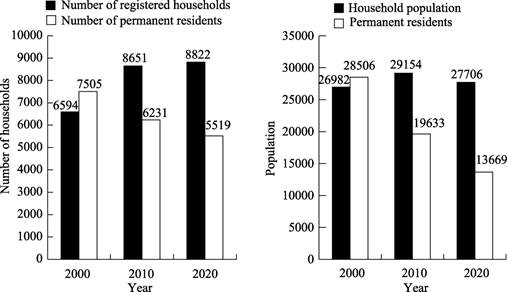 |
Table 7 Households and population in Baoshan town (as of December 18, 2021).
| Village | Number of registered households | Number of permanent (Actual) households | Household: permanent/ Registered ( % ) | Registered household residents | Permanent (Actual) residents | Population: actual/ registered ( % ) | Birth population | Dead population | Birth: Death |
|---|---|---|---|---|---|---|---|---|---|
| Baoshan | 762 | 516 | 67.71 | 2,096 | 1,254 | 59.83 | 8 | 10 | 1:1.25 |
| An lok | 526 | 311 | 59.13 | 1,527 | 791 | 51.81 | 6 | 5 | 1:0.83 |
| Beihe | 676 | 289 | 42.75 | 2,012 | 744 | 36.98 | 6 | 11 | 1:1.83 |
| Chejia | 303 | 253 | 83.5 | 1,022 | 567 | 55.48 | 4 | 7 | 1:1.75 |
| Xidagou | 906 | 607 | 67 | 2,972 | 1,538 | 51.75 | 6 | 21 | 1:3.5 |
| Xigudingzi | 680 | 410 | 60.29 | 2,185 | 1,067 | 48.83 | 6 | 13 | 1:2.17 |
| Yokogawa | 361 | 228 | 63.16 | 1,243 | 567 | 45.62 | 4 | 11 | 1:2.75 |
| Kaoshan | 606 | 370 | 61.06 | 1,620 | 837 | 51.67 | 2 | 7 | 1:3.5 |
| Changxing | 773 | 493 | 63.78 | 2,516 | 1,093 | 43.44 | 6 | 9 | 1:1.5 |
| Liangzihe | 363 | 222 | 61.16 | 1,153 | 513 | 44.49 | 2 | 3 | 1:1.5 |
| Taiping | 937 | 559 | 59.66 | 2,820 | 1,427 | 50.6 | 6 | 9 | 1:1.5 |
| Guokui | 869 | 571 | 65.71 | 2,859 | 1,438 | 50.3 | 10 | 10 | 1:1 |
| Beiguokui | 236 | 166 | 70.34 | 790 | 423 | 53.54 | 5 | 5 | 1:1 |
| Chamdo | 832 | 522 | 62.74 | 2,816 | 1,371 | 48.69 | 6 | 6 | 1:1 |
| Total | 8,830 | 5,571 | 63.09 | 27,631 | 13,630 | 49.33 | 77 | 127 | 1:1.65 |
Economy of the Case Area
According to incomplete statistics, the GDP of Baoshan town in 2020 was 97 million CNY (Chinese Yuan). Calculated by the actual resident, the per capita GDP was 7,096 CNY. The contribution to the GDP mainly comes from rice, poultry, aquatic products, and food. Due to the low degree of marketization of Chinese cherry apples, relevant statistics are still missing.
Fruit Harvest, Storage, and Transportation Needs to be Improved
At present, the management of Chinese cherry apple in Baoshan town is in traditional stage. As natural conditions are favorable, the yield is relatively stable. However, these fruits need to be picked, sorted and transported to the destination market in time to get ideal benefits. Unfortunately, we cannot fully meet these needs at present, and these deficiencies prevent these quality fruits from obtaining the benefits they should have. In the future, we will gradually improve these infrastructures.
Standardization, Specifications, and Marketing
The standards and specifications related to orchard management, fruit grading and preservation have been incorporated into the local development plan. The marketing of Chinese cherry apple is run by Jilin Panbao Agricultural Products Co., Ltd., and Xinyu Fruit Tree Planting Professional Cooperative. The protection of the Chinese cherry apple habitat in Panshi is jointly managed by the village collective registered enterprise and the Xinyu Fruit Tree Planting Professional Cooperative. Unified planting and operation are key components of the supervision of the Baoshan town government.
Brief History and Development of Panshi Chinese Cherry Apple
Guokui (helmet) Mountain region is the core area of Chinese cherry apple in Panshi city. This area started to be reclaimed in 1874, and was renamed Panshi(Monolith)in 1882. Chinese cherry apple started to be planted in Guokui mountain region in 1960s; and Guokui village became a specialized fruit village in 1992; in 2010, Guokui village was named “the first red fruit village in Northeast China”[13]. In 2021, Panshi Fruit Modern Agricultural Industrial Park was settled in Baoshan town. This industrial park will benefit 1,280 households, equivalent to 22.98% of the actual permanent households in Baoshan in 2021.
Discussion and Conclusion
The Panshi Chinese cherry apple low mountains and hills case lies in the transitional area from the Changbai mountains to Songnen plain, with Baoshan town as its core. Thanks to its superior natural conditions, especially its clean and pollution-free water source, the region has produced high-quality Chinese cherry apple with geographical characteristics. In the future, the advantages of natural resources and products can be transformed into market advantages by strengthening infrastructure, so as to promote local economy, create more employment opportunities for local people, promote population return and revitalize the countryside.
References
[1] Panshi Local Chronicle Compilation Committee. Panshi City Chronicle (1991–2003) [M]. Chuangchun: Jilin Literature and History Publishing House, 2006.
[2] Chinese Academy of Sciences. White paper on black land in Northeast China (2020) [R]. 2021.
[3] Li, S. T. General History of Northeast China [M]. Chuangchun: Jilin Literature and History Publishing House, 1991.
[4] Panshi Town Chronicle Compilation Committee. Panshi Town Chronicle [M]. Chuangchun: Jilin People’s Publishing House, 1999.
[5] Pang, X. L., Li, B. Y. Comprehensive analysis of climate characteristics in Panshi city in 2017 [J] .Modern Agricultural Science and Technology, 2018(22): 223, 226.
[6] Zhang, J. J. Research on the allocation of water resources in medium and small watersheds [D]. Beijing: China Academy of Water Resources and Hydropower, 2018.
[7] Chen, S. B, Ye, Y. H., Fu, J. Y., et al. Panshi Chinese cherry apple Baoshan low mountains and hills case dataset on ecosystem protection and sustainable development [J/DB/OL]. Digital Journal of Global Change Data Repository, 2021. https:/ /doi.org/10.3974/geodb.2021.12.41.V1. https://cstr.escience.org.cn/CSTR:20146.11.2021.12.41.V1.
[8] GCdataPR Editorial Office. GCdataPR data sharing policy [OL]. https://doi.org/10.3974/dp.policy.2014.05 (Updated 2017).
[9] Peng, H. K., Xue, H. F., Chi, D. A new apple variety “Chicken Heart Fruit” and its cultivation technique [J]. Modern Agriculture, 2017(10): 10.
[10] High-quality cold-resistant small apple-Chicken heart fruit [J]. Inner Mongolia Forestry, 2012(1).
[11] Qu, C. G. Biological characteristics and cultivation techniques of Chinese cherry apple [J]. Agricultural Development and Equipment, 2020(4): 197, 200.
[12] Wang, B. X., Dong, Z. Y., Zhang, X. J. et al. Breeding of high-quality small apples―‘saiwaihong’ [J]. Journal of Fruit Trees, 2014(31): 739–741.
[13] Shen, Q. The First Village of Hongguo in Guandong [M]. Beijing: Social Science Literature Publishing House, 2010.
Case Team
Principle Investigator
Principle Investigator Chen Shengbo
Chen Shengbo, born in September 1967 in Luoshan, Henan Province, is a professor and doctoral supervisor at Jilin University. He is also a specially appointed professor of "Changbai Mountain Scholars" and enjoys the allowance of the State Council. In 2007, he was selected for the "New Century Excellent Talent Support Program" by the Ministry of Education. In 2012, he was selected for the Huang Jiqing Youth Geological Science and Technology Award by the Chinese Geological Society. In 2013, he was selected as the third batch of outstanding innovative talents in Jilin Province. In 2016, he was awarded the "Three Education" model by Jilin University. In 2020, he was awarded the title of "Most Beautiful Science and Technology Worker in Jilin Province". Graduated from Changchun Geological College with a Bachelor's degree in Geological Mineral Survey and Exploration in June 1992; Graduated from Changchun Geological College with a master's degree in remote sensing geology in June 1996; Graduated from Jilin University in June 2000 with a doctoral degree in Earth Exploration and Information Technology. In January 2003, the post doctor of geography of Institute of Geographic Sciences and Natural Resources Research, Chinese Academy of Sciences left the station; Visiting scholar at the Canadian University of Saskatchewan Institute of Space and Atmospheric Sciences from June 2003 to June 2004; Visiting Professor at International Bremen University in Germany from March 2006 to May 2006. The current director of Jilin Data and Application Center for High Resolution Earth Observation System, Jilin Satellite Comprehensive Application Engineering Laboratory, Jilin Key Laboratory of Surveying and Remote Sensing in Higher Education Institutions, and Jilin Satellite Application Public Technology Research and Development Center of the State Administration of Science and Technology for National Defense, as well as the director of Jilin High Resolution Telesensing Research Institute. He also serves as the Vice Chairman of the Jilin Remote Sensing Society, Executive Director of the Expert Committee of the China Remote Sensing Application Association, Member of the Scientific Application Expert Committee of the Lunar Exploration Engineering of the National Defense Science and Technology Commission, Senior Professor of the Center for Excellence in Comparative Planetary Science of the Chinese Academy of Sciences, Member of the Lunar Spherical Science and Comparative Planetary Science Professional Committee of the Chinese Society of Space Sciences, IEEE and AGU Members, and Editorial Board Member of the National Remote Sensing Bulletin.
Expert members of the case team
Ye Yinghui, lecturer, School of Earth Exploration Science and Technology, Jilin University
Fu Jingying, Associate Professor, Institute of Geographic Sciences and Natural Resources Research,Chinese Academy of Sciences
Zhang Maojun, Director, Pomology Research Institute, Jilin Academy of Agricultural Sciences
Qiao Yunbo, Deputy Director, Panshi City Agriculture and Rural Affairs Bureau
Yao Liping, Director, People's Government of Baoshan Township, Panshi City
Luan Rensheng, General Manager, Jilin Province Panbao Agricultural Products Co.,Ltd
Zhu Xiaoguang, General Manager, Beijing Tianhang Create Technology Co., Ltd
Chen Cunhua, Section Chief, Panshi City Agriculture and Rural Affairs Bureau
Wu Lianguo, Secretary of the Town Party Committee, People's Government of Baoshan Township, Panshi City
Qi Zhaoming, General Manager, Jilin Province Panbao Agricultural Products Co.,Ltd
Liu Chuang, Professor, Institute of Geographic Sciences and Natural Resources Research, Chinese Academy of Science
Author Contributions
Chen, S. B. and Ye, Y. H. designed the dataset and wrote the first draft of the paper; Liu, C. and Fu, J. Y. revised the development plan of the datasets and the first draft of the paper; Ye, Y. H. tested samples of soil, water, and fruit trees; Yao, L. P., Wu, L. G., Qiao, Y. B., Chen, C. H., and Zhu, X. G. provided monitoring data; Yao, L. P. provided socioeconomic and demographic data; Zhang, M. J., Luan, R. S., and Qi, Z. M. collected fruit management data; Liu, C. finalized the paper.
Acknowledgements
We sincerely thank the following people for their help in completing this case: Fu, B. J., Academician of the Chinese Academy of Sciences; He, C. C., former Deputy Director- General of FAO, Academician of the Eurasian Academy of Sciences; Wang, Z. B. and Zhang, M. of Cooperation Division of IGSNRR/CAS; Wang, Z. X. and Shi, R. X. from Global Change Research Data Publishing and Repository; Yu, J. Q., Secretary of Panshi Municipal CCP; Wang, P. P., Mayor of Panshi city; Qi, W., Vice Mayor of Panshi city; Wang, Z. W., Director of Agriculture and Rural Affairs Bureau of Panshi city.
